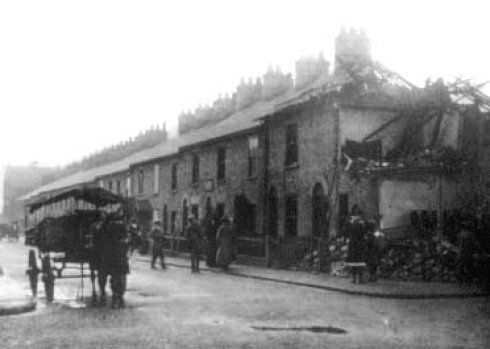9/10 August 1915
Bombed:
E. Yorks, Kent & Suffolk
On 9th August, five Zeppelins set out to raid England. The older L 9 targeted the Humber while four newer models, the L 10, L 11, L 12 and L 13, aimed for London. L 13 turned back early with engine problems.
L 9, commanded by Kapitänleutnant Odo Loewe, came inland after a couple of encounters with RNAS aircraft. He believed he bombed Hull, but was further west, his bombs dropping on Goole. Crossing the River Ouse his eight explosive and 13 incendiary bombs fell from east to west. The first deaths were at 2 Sotheron Street – at the junction of Victoria Street - where 65-year-old widow Sarah Acaster, who ran a fish and chip shop, her two grown up daughters, Kezia and Sarah Ann, and a visitor, died in the wreckage of the house. Other bombs, falling on an area between North Street and Aire Street where, within a locality bordered by George Street, Ouse Street, North Street and Bromley’s Yard, ten small houses were wrecked and 12 people killed. There were no more losses after that, but L 9 dropped 16 more bombs, causing damage on the docks and railway sidings before departing. On her route back to the coast, L 9 dropped three incendiaries on an open field at Hotham. Total casualties in Goole were 16 killed and 11 wounded.
L 10, commanded by Oberleutnant-zur-See Friedrich Wenke, reported that he had reached the outskirts of London and bombed shipping in the Thames. In fact, he lost his way and eventually dropped his bombs on the Isle of Sheppey, coming close to the RNAS base at Eastchurch. Wenke reported dropping 82 bombs in total, but only 14 were discovered on land. Six explosive and six incendiaries landed on the airfield, many close to the hangers, but the only damage was broken glass. About half a mile south east of Eastchurch, two explosive bombs dropped at Pump Hill where they caused no damage.
The Zeppelin Raid memorial in Goole cemetary. The memorial is in the form of an open book bearing the names of the 16 victims of the raid and is positioned over their mass grave.
(Courtesy of the Goole First World War Research Group - www.goolefirstworldwar.blogspot.co.uk)
Zeppelin L 11, attacked Lowestoft, believing it was bombing Harwich. Her commander, Oberleutnant-zur-See H von Buttlar, claimed to have dropped 88 bombs, but as only seven explosive bombs were located on land and four incendiaries fell in the sea close to the shore, it is presumed the rest fell further out to sea. One also fell on Leggetts Farm at Pakefield causing £2 10s (£2.50) worth of damage. In Lowestoft bombs dropped on The Avenue, Lovewell Road, Lorne Park Road, London Road, Wellington Esplanade (two) and Wellington Road. The bomb at 12 Lovewell Road destroyed the property, and that at No.14: 18-year-old Kate Crawford died and three others were injured. At 2 Wellington Esplanade the blast injured the owner, Miss E. Gridley, and three soldiers of 2/4th Norfolk Regt. billeted there. Casualties in Lowestoft were one killed and seven injured.
While all the above raiders escaped unscathed, Zeppelin L 12 was not so lucky. Oberleutnant-zur-See Werner Peterson found himself blown way off course and approached Dover at a low height of about 3500ft, thinking he was over Harwich. Immediately illuminated by searchlights, two 6-pdrs, a 3-inch gun and five 1-pdr pom-poms opened fire. It appears a shell from the 3-pdr struck L 12, which immediately climbed to escape, also dropping about 10 bombs. Six landed in the sea while two incendiaries struck the parapet of Admiralty Pier and burnt themselves out, while a third fell through the corrugated iron roof of the Transport Office and set fire to the platform but was quickly extinguished. A final, explosive, bomb fell under the bows of the trawler Equinox, wounding three men.
L 12 began to lose a lot of hydrogen due to the damage caused over Dover. She eventually came down in the sea a few miles out from Ostend. Torpedo boats towed her into harbour. Numerous attempts by aircraft to destroy her failed; she finally burst into flames and was destroyed while being hauled out onto the dock.
One of the Home Defence aircraft, a Sopwith Tabloid flown by Flight sub-Lieutenant R. Lord from Westgate, crashed on landing and the pilot died from his injuries.
Lowestoft. Bomb damage to 12 Lovewell Road (on the corner) where Kate Crawford died.
Casualties: 17 killed, 21 injured
Damage: £11, 992

